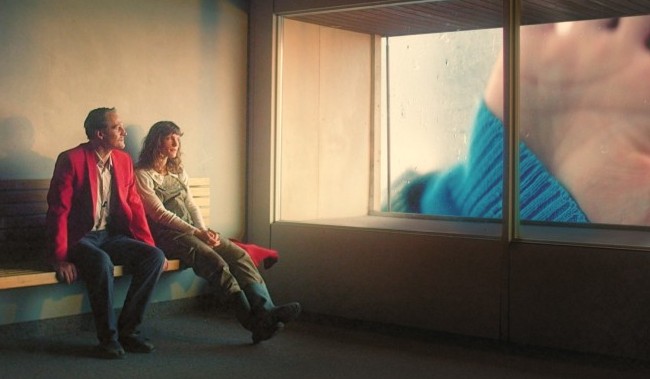
Disc Reviews
Aloys Blu-ray Review

Aloys is Aloys Adorn. He is a rather doleful and dour private investigator who lives alone in a high rise block of flats with his cat and elderly father. He spends his time in the evenings obsessively watching the surveillance videos he has taken for his clients on DV. When his father dies he stands alone at the crematorium clearly indicating that his father was also a loner. After his father’s death he continues to live his life as he did before. A short while later he discovers that his neighbour has attempted suicide and he is left looking after her pet lizard. One evening after the funeral he goes out alone and gets drunk. Falling asleep in the bus, he wakes from his drunken stupor to discover that his bag containing her personal belongings including his video camera and tapes have been taken. A couple of days later he is called by a mysterious female who says that she has his things and tries to blackmail him. She requests that they play a Japanese game called ‘telephone walking’ whereby they use their imaginations and give instructions, almost like telephonic charades. Aloys imagines that the mysterious caller is his neighbour who had attempted suicide. In time he starts to become obsessed with the calls believing the calls give his life some meaning and even imagines himself to be in love with the mysterious caller. This is where the viewer is drawn into being a part of Aloys’s paranoia and fantasies. We are never sure that what we are seeing is in Aloys’s imagination or is real. In one scene he is in a bar and asks a transsexual whether she is the person calling him. She looks at him confused. Later in the film we see her at a party with a couple of other guests enjoying the glitter ball party taking place in Aloys’s flat while the he and the girl in question, Vera are playing the organ together. The other two guests were seen earlier in the apartment block walking a sheep. Elsewhere we see Aloys asleep on the floor of Vera’s hospital room, recovering from her suicide. Is this a dream or reality? I would suggest the former.
It is this surrealism and the strange dreamlike imagery and displacement that leads the a viewer to be reminded of such antecedents as Luis Buñuel and more recently the strange almost narrative-less films of Swedish director Roy Andersson (with such films as You the Living, 2007 and A Pigeon Sat on a Branch Reflecting on Existence, 2014). Other critics have compared this film to the writings of Charlie Kaufman (Eternal Sunshine of the Spotless Mind, 2004). It is this surreal aspect that perhaps most closely resembles Buñuel with the disjunction between reality and dream such as Catherine Deneuve’s sexual fantasies in Belle de Jour (1967), the viewer never clear which is which. However, unlike Andersson’s films, Aloys is not heavy going and is actually a quite captivating film never totally throwing the viewer off track.
It is an ambitious, clever and even remarkable second film for Swiss director Tobias Nölle that is given extra style by the wonderfully shot cinematographer Simon Guy Fässler, who previous to this film had filmed documentaries and also been the cinematographer to Nölle’s first film, Wonderland (2015). He has beautifully captured the muted coloured tones of Aloys’s bland apartment or the misty urban tower block in which he lives.The film never makes clear where the film is set, but is spoken in Swiss German, it does suggest that it is probably in the north of Switzerland. Released by Eureka! the film has no extras to speak of (the film was only given a limited release in the UK in September) but it is a gorgeous transfer.
Chris Hick




